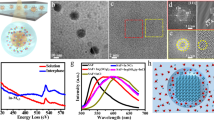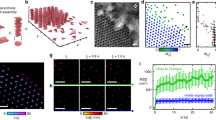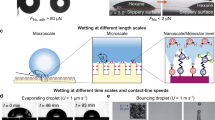Abstract
Solid–liquid interfaces play a fundamental role in surface electrochemistry1, catalysis2, wetting3, self-assembly4 and biomolecular functions5. The interfacial energy determines many of the properties of such interfaces, including the arrangement of the liquid molecules at the surface of the solid. Diffraction techniques are often used to investigate the structure of solid–liquid interfaces6, but measurements of irregular or inhomogeneous interfaces remain challenging. Here, we report atomic- and molecular-resolution images of various organic and inorganic samples in liquids, obtained with a commercial atomic force microscope operated dynamically with small-amplitude modulation. This approach uses the structured liquid layers close to the solid to enhance lateral resolution. We propose a model to explain the mechanism dominating the image formation, and show that the energy dissipated during this process is related to the interfacial energy through a readily achievable calibration curve. Our topographic images and interfacial energy maps could provide insights into important interfaces.
This is a preview of subscription content, access via your institution
Access options
Subscribe to this journal
Receive 12 print issues and online access
$259.00 per year
only $21.58 per issue
Buy this article
- Purchase on Springer Link
- Instant access to full article PDF
Prices may be subject to local taxes which are calculated during checkout



Similar content being viewed by others
References
Wandelt, K. & Thurgate, S. Solid–Liquid Interfaces: Macroscopic Phenomena, Microscopic Understanding (Springer, 2003).
Hoffmann, M. R., Martin, S. T., Choi, W. Y. & Bahnemann, D. W. Environmental applications of semiconductor photocatalysis. Chem. Rev. 95, 69–96 (1995).
Centrone, A. et al. The role of nanostructure in the wetting behavior of mixed-monolayer-protected metal nanoparticles. Proc. Natl Acad. Sci. USA 105, 9886–9891 (2008).
Whitesides, G. M. & Grzybowski, B. Self-assembly at all scales. Science 295, 2418–2421 (2002).
Frauenfelder, H., Fenimore, P. W., Chen, G. & McMahon, B. H. Protein folding is slaved to solvent motions. Proc. Natl Acad. Sci. USA 103, 15469–15472 (2006).
Fenter, P. & Sturchio, N. C. Mineral-water interfacial structures revealed by synchrotron X-ray scattering. Prog. Surf. Sci. 77, 171–258 (2004).
Binnig, G., Quate, C. F. & Gerber, C. Atomic force microscope. Phys. Rev. Lett. 56, 930–933 (1986).
Quate, C. F. The AFM as a tool for surface imaging. Surf. Sci. 299–300, 980–995 (1994).
Giessibl, F. J. Atomic resolution of the silicon (111)–(7×7) surface by atomic force microscopy. Science 267, 68–71 (1995).
Hembacher, S., Giessibl, F. J. & Mannhart, J. Force microscopy with light-atom probes. Science 305, 380–383 (2004).
Sugawara, Y., Ohta, M., Ueyama, H. & Morita, S. Defect motion on an InP(110) surface observed with noncontact atomic force microscopy. Science 270, 1646–1648 (1995).
Sugimoto, Y. et al. Chemical identification of individual surface atoms by atomic force microscopy. Nature 446, 64–67 (2007).
Gan, Y. Atomic and subnanometer resolution in ambient conditions by atomic force microscopy. Surf. Sci. Rep. 64, 99–121 (2009).
Oesterhelt, F. et al. Unfolding pathways of individual bacteriorhodopsins. Science 288, 143–146 (2000).
Ohnesorge, F. & Binnig, G. True atomic resolution by atomic force microscopy through repulsive and attractive forces. Science 260, 1451–1456 (1993).
Giessibl, F. J. Advances in atomic force microscopy. Rev. Mod. Phys. 75, 949–983 (2003).
García, R. & Pérez, R. Dynamic atomic force microscopy methods. Surf. Sci. Rep. 47, 197–301 (2002).
O'Shea, S. J., Lantz, M. A. & Tokumoto, H. Damping near solid–liquid interfaces measured with atomic force microscopy. Langmuir 15, 922–925 (1999).
Li, T.-D. & Riedo, E. Nonlinear viscoelastic dynamics of nanoconfined wetting liquids. Phys. Rev. Lett. 100, 106102 (2008).
Fukuma, T., Ueda, Y., Yoshioka, S. & Asakawa, H. Atomic-scale distribution of water molecules at the mica-water interface visualized by three-dimensional scanning force microscopy. Phys. Rev. Lett. 104, 016101 (2010).
Fukuma, T., Higgins, M. J. & Jarvis, S. P. Direct imaging of lipid-ion network formation under physiological conditions by frequency modulation atomic force microscopy. Phys. Rev. Lett. 98, 106101 (2007).
Israelachvili, J. & Wennerstrom, H. Role of hydration and water structure in biological and colloidal interactions. Nature 379, 219–225 (1996).
Butt, H.-J. & Stark, R. Atomic force microscopy in structured liquids: remark on the interpretation of jumps in force curves. Coll. Surf. A 252, 165–168 (2005).
Dupré, A. Théorie Mécanique de la Chaleur (Gauthier-Villars, 1869).
Yu, C. J. et al. Order in molecular liquids near solid–liquid interfaces. Appl. Surf. Sci. 182, 231–235 (2001).
Israelachvili, J. N. Intermolecular and Surface Forces, With Applications to Colloidal and Biological Systems 2nd edn (Academic Press, 1992).
Poynor, A. et al. How water meets a hydrophobic surface. Phys. Rev. Lett. 97, 266101 (2006).
Chandler, D. Interfaces and the driving force of hydrophobic assembly. Nature 437, 640–647 (2005).
Cleveland, J. P., Anczykowski, B., Schmid, A. E. & Elings, V. B. Energy dissipation in tapping-mode atomic force microscopy. Appl. Phys. Lett. 72, 2613–2615 (1998).
Fenter, P., Park, C., Nagy, K. L. & Sturchio, N. C. Resonant anomalous X-ray reflectivity as a probe of ion adsorption at solid–liquid interfaces. Thin Solid Films 515, 5654–5659 (2007).
Kuna, J. J. et al. The effect of nanometre-scale structure on interfacial energy. Nature Mater. 8, 837–842 (2009).
Ingebrigtsen, T. & Toxvaerd, S. Contact angles of Lennard–Jones liquids and droplets on planar surfaces. J. Phys. Chem. C 111, 8518–8523 (2007).
Melcher, J. et al. Origins of phase contrast in the atomic force microscope in liquids. Proc. Natl Acad. Sci. USA 106, 13655–13660 (2009).
Acknowledgements
K.V. acknowledges support from the Swiss National Science Foundation. F.S. acknowledges the generous support of the Packard Foundation, and from the Department of Defence Defense Threat Reduction Agency (BRBAA08-L-2-0031). E.T. acknowledges support by Consiglio Nazionale delle Ricerche (CNR) through Eurocore ‘Friction and Adhesion in Nanomechanical Systems’ (FANAS) project Atomic Friction (AFRI).
Author information
Authors and Affiliations
Contributions
K.V. and F.S. designed the experiment. Sample preparation, measurements and data analysis were carried out by K.V. (AFM) and J.K. (CA). The model was developed by K.V., with contributions from S.A.C., E.T., J.K. and F.S. K.V. and F.S. wrote the paper. All authors discussed and commented on the manuscript.
Corresponding author
Ethics declarations
Competing interests
The authors declare no competing financial interests.
Supplementary information
Supplementary information
Supplementary information (PDF 1079 kb)
Rights and permissions
About this article
Cite this article
Voïtchovsky, K., Kuna, J., Contera, S. et al. Direct mapping of the solid–liquid adhesion energy with subnanometre resolution. Nature Nanotech 5, 401–405 (2010). https://doi.org/10.1038/nnano.2010.67
Received:
Accepted:
Published:
Issue Date:
DOI: https://doi.org/10.1038/nnano.2010.67
This article is cited by
-
Real-time tracking of ionic nano-domains under shear flow
Scientific Reports (2021)
-
Wideband Magnetic Excitation System for Atomic Force Microscopy Cantilevers with Megahertz-Order Resonance Frequency
Scientific Reports (2020)
-
Direct quantification of nanoparticle surface hydrophobicity
Communications Chemistry (2018)
-
Direct observation of the dynamics of single metal ions at the interface with solids in aqueous solutions
Scientific Reports (2017)
-
Angstrom-Resolved Metal-Organic Framework-Liquid Interfaces
Scientific Reports (2017)



